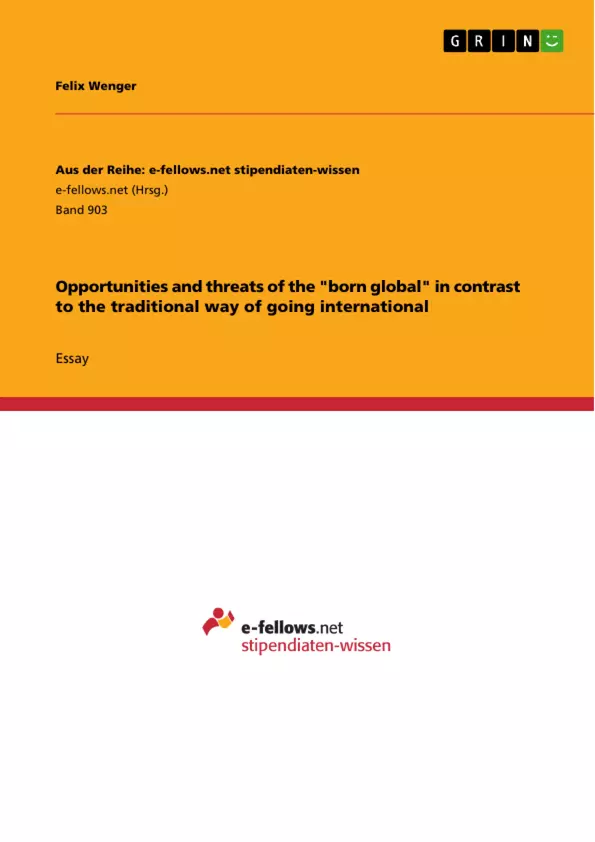Globalisation is omnipresent in today’s society and economy. The reduction of international communication and logistic costs, the increase in customer mobility and market homogeneity and other present-day trends are among the reasons for the emergence of small and medium firms which are able to operate internationally rapidly after inception – so-called ‘Born globals’. But while the new research field of ‘International entrepreneurship’ focuses mainly on the phenomenon and process of internationalization a lack of insight into the challenges, which Born globals are confronted with during their internationalization process, is apparent. Important in this case is the question of how these challenges differ from those of traditional internationalizing small and medium enterprises. This essay will examine the definition and characteristics of born global small and medium enterprises, and will then go on to analyse the reasons for the emergence and review related literature to found conceptual foundation for the discussion. Subsequent will be the discussion of opportunities and threats of the born global way in contrast to the traditional way of internationalization. Finally, a conclusion will reflect on the main findings of this work.
Inhaltsverzeichnis
- 1 Chancen und Risiken des „Born Global“-Ansatzes im Vergleich zur traditionellen Internationalisierung
Zielsetzung und Themenschwerpunkte
Diese Arbeit untersucht die Chancen und Risiken der „Born Global“-Internationalisierung im Vergleich zum traditionellen Ansatz. Sie beleuchtet die Definition und Charakteristika von Born Global Unternehmen (BGU), analysiert die Gründe für deren Entstehung und diskutiert relevante Literatur. Im Fokus stehen die spezifischen Herausforderungen und Möglichkeiten, denen BGU im Internationalisierungsprozess begegnen.
- Definition und Charakteristika von Born Global Unternehmen
- Gründe für die Entstehung von Born Global Unternehmen
- Chancen der Born Global Strategie
- Risiken der Born Global Strategie
- Vergleich mit traditionellen Internationalisierungsansätzen
Zusammenfassung der Kapitel
1 Chancen und Risiken des „Born Global“-Ansatzes im Vergleich zur traditionellen Internationalisierung: Dieses Kapitel analysiert die "Born Global"-Firmen, die von Anfang an international ausgerichtet sind. Es untersucht die Chancen und Risiken dieses Ansatzes im Vergleich zur traditionellen, schrittweisen Internationalisierung. Es werden die Definitionen und Charakteristiken von Born Globals beleuchtet und die Gründe für ihr Entstehen anhand makro- und mikroökonomischer Faktoren erörtert. Der Text vergleicht die Herausforderungen, denen Born Globals und traditionelle KMUs begegnen, und zeigt auf, wie etablierte Internationalisierungstheorien nur bedingt auf Born Globals anwendbar sind. Es wird ein eigenes konzeptionelles Modell vorgestellt, das die verschiedenen Phasen der Born Global-Strategie beschreibt – von der Unternehmerpersönlichkeit über Finanzierungsaspekte, Produkt- und Prozessgestaltung bis hin zur Marktwahl und der Etablierung eines nachhaltigen Geschäftsmodells. Besondere Aufmerksamkeit wird den Rollen von Netzwerken und Ressourcen gewidmet, um die Herausforderungen bei der Gründung und dem Aufbau eines nachhaltigen Unternehmens auf Born-Global-Basis zu veranschaulichen.
Schlüsselwörter
Born Global, Internationalisierung, KMU, Chancen, Risiken, Netzwerke, Ressourcen, Wettbewerbsvorteil, Internationales Unternehmertum, Marktstrategie.
Frequently Asked Questions: Chancen und Risiken des „Born Global“-Ansatzes im Vergleich zur traditionellen Internationalisierung
Was ist der Gegenstand dieser Arbeit?
Diese Arbeit untersucht die Chancen und Risiken der „Born Global“-Internationalisierung im Vergleich zu traditionellen Internationalisierungsansätzen. Sie analysiert Born Global Unternehmen (BGU), ihre Entstehung, und die spezifischen Herausforderungen und Möglichkeiten im Internationalisierungsprozess.
Was sind Born Global Unternehmen (BGU)?
Die Arbeit definiert und charakterisiert Born Global Unternehmen. Es handelt sich dabei um Unternehmen, die von Beginn an international ausgerichtet sind und im Gegensatz zu traditionellen Unternehmen nicht schrittweise, sondern sofort global agieren.
Warum entstehen Born Global Unternehmen?
Die Arbeit beleuchtet die Gründe für die Entstehung von BGUs. Dies geschieht unter Berücksichtigung makro- und mikroökonomischer Faktoren.
Welche Chancen bietet die Born Global Strategie?
Die Arbeit identifiziert und beschreibt die Chancen, die mit einer Born Global Strategie verbunden sind. Dies könnte beispielsweise den Zugang zu größeren Märkten und damit verbundene Skaleneffekte umfassen.
Welche Risiken birgt die Born Global Strategie?
Die Arbeit identifiziert und beschreibt die Risiken, die mit einer Born Global Strategie verbunden sind. Dies könnte beispielsweise höhere Anfangsinvestitionen und größere Unsicherheiten im Ausland umfassen.
Wie unterscheidet sich die Born Global Strategie von traditionellen Internationalisierungsansätzen?
Die Arbeit vergleicht die Born Global Strategie mit traditionellen, schrittweisen Internationalisierungsansätzen. Sie zeigt auf, in welchen Punkten sich die Herausforderungen und Strategien unterscheiden und wie etablierte Internationalisierungstheorien auf Born Globals anwendbar sind.
Welche Rolle spielen Netzwerke und Ressourcen bei Born Global Unternehmen?
Die Arbeit betont die Bedeutung von Netzwerken und Ressourcen für den Erfolg von Born Global Unternehmen, insbesondere bei der Gründung und dem Aufbau eines nachhaltigen Geschäftsmodells.
Welche Phasen umfasst die Born Global Strategie laut dem in der Arbeit vorgestellten Modell?
Das in der Arbeit vorgestellte konzeptionelle Modell beschreibt verschiedene Phasen der Born Global-Strategie, von der Unternehmerpersönlichkeit über Finanzierungsaspekte, Produkt- und Prozessgestaltung bis hin zur Marktwahl und der Etablierung eines nachhaltigen Geschäftsmodells.
Welche Schlüsselwörter charakterisieren die Arbeit?
Schlüsselwörter sind: Born Global, Internationalisierung, KMU, Chancen, Risiken, Netzwerke, Ressourcen, Wettbewerbsvorteil, Internationales Unternehmertum, Marktstrategie.
Welche Kapitel enthält die Arbeit?
Die Arbeit enthält mindestens ein Kapitel: "Chancen und Risiken des „Born Global“-Ansatzes im Vergleich zur traditionellen Internationalisierung". Weitere Kapitel sind aus dem Inhaltsverzeichnis nicht direkt ersichtlich.
- Quote paper
- Felix Wenger (Author), 2008, Opportunities and threats of the "born global" in contrast to the traditional way of going international, Munich, GRIN Verlag, https://www.grin.com/document/143342



